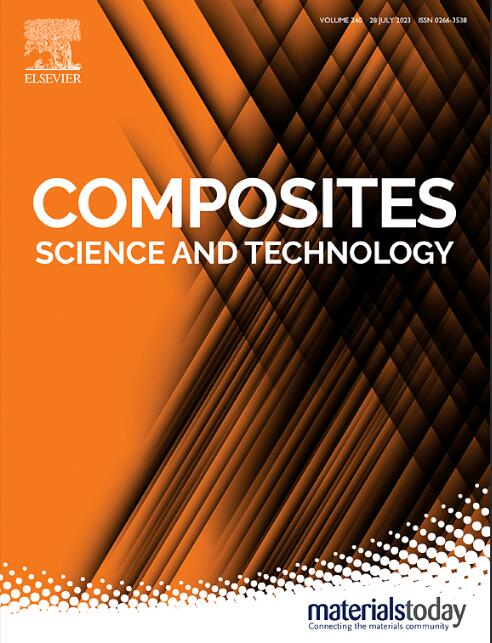碳纤维集流复合电极锂化致变形的力学电化学分析
IF 8.3
1区 材料科学
Q1 MATERIALS SCIENCE, COMPOSITES
引用次数: 0
摘要
复合结构电池通常使用碳纤维(CFs)作为集流器。使用活性材料形成复合电极的碳纳米管在电化学反应中的作用非常复杂,因为用作集流器的碳纳米管也会发生锂离子嵌入,导致体积膨胀和变形。利用原位电化学电池测量装置,研究了正极、负极、石墨-碳纤维双层电极(GCBE)和磷酸铁锂-碳纤维双层电极(LCBE)的锂化电位与偏转的关系。实验结果表明,在相同厚度比下,LCBE在锂化过程中的挠度仅为GCBE的13.3%。LCBE中的CFs主要作为电子传输的电流收集器,对电势的影响最小。相比之下,GCBE中的CFs不仅充当电子输运的集流器,还参与部分电化学反应,改变放电曲线,降低电极电位。建立了复合电极颗粒间机械应力与集流器锂化的数值模型。数值模拟结果表明,复合电极中的质谱抑制了活性材料的浓度、锂化速率和表面应力,但促进了集电极的锂离子浓度、锂化速率和表面应力,改变了锂离子分布,特别是在LCBE的cf中。此外,石墨层与碳纳米管的厚度比对锂化过程中的扩散速率和偏转趋势有显著影响。当石墨层厚度超过碳纤维厚度时,挠度曲线呈现单调增加的趋势。相反,当石墨厚度小于CF厚度时,挠度曲线呈现先增大后减小的趋势。本文章由计算机程序翻译,如有差异,请以英文原文为准。
Mechano-electrochemical analysis of lithiation-induced deformation of composite electrodes using carbon fibre as current collector
Composite structure batteries often use carbon fibres (CFs) as current collectors. CFs with active materials to form composite electrodes introduces complexity in understanding their role during electrochemical reactions, as the CFs used as current collectors also undergo lithium-ion intercalation, leading to volume expansion and deformation. This study investigates the relationship between lithiation potential and deflection for anode and cathode, graphite-carbon fibre bilayer electrodes (GCBE) and lithium iron phosphate-carbon fibre bilayer electrodes (LCBE), using an in-situ electrochemical cell measurement device. Experimental results indicate that, for the same thickness ratio, during the lithiation the deflection of LCBE is only 13.3 % of that of GCBE. The CFs in LCBE primarily function as current collectors for electron transport and have minimal impact on the potential. In contrast, the CFs in GCBE not only serve as current collectors for electron transport but also participate in partial electrochemical reactions, altering the discharge curve and reducing the electrode potential. A numerical model incorporating mechanical stress (MS) between composite electrode particles and current collector lithiation of composite electrodes was developed. Numerical simulation results reveal that MS in composite electrodes inhibits the concentration, lithiation rate and surface stress of active materials, but promotes them of the current collector, altering the lithium ions distribution especially in the CFs of the LCBE. Additionally, the thickness ratio between the graphite layer and CFs in the GCBE significantly impacts the diffusion rate and the deflection trend during lithiation. When the graphite layer thickness exceeds the CF thickness, the deflection curve shows a monotonically increasing trend. Conversely, when the graphite thickness is less than the CF thickness, the deflection curve exhibits an initial increase followed by a decrease.
求助全文
通过发布文献求助,成功后即可免费获取论文全文。
去求助
来源期刊

Composites Science and Technology
工程技术-材料科学:复合
CiteScore
16.20
自引率
9.90%
发文量
611
审稿时长
33 days
期刊介绍:
Composites Science and Technology publishes refereed original articles on the fundamental and applied science of engineering composites. The focus of this journal is on polymeric matrix composites with reinforcements/fillers ranging from nano- to macro-scale. CSTE encourages manuscripts reporting unique, innovative contributions to the physics, chemistry, materials science and applied mechanics aspects of advanced composites.
Besides traditional fiber reinforced composites, novel composites with significant potential for engineering applications are encouraged.
 求助内容:
求助内容: 应助结果提醒方式:
应助结果提醒方式:


